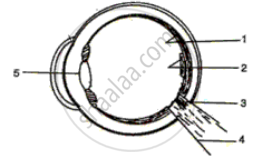Advertisements
Advertisements
प्रश्न
What is short-sightedness? State the two causes of short-sightedness (or myopia). With the help of ray diagrams, show:
(i) the eye-defect short-sightedness.
(ii) correction of short-sightedness by using a lens.
उत्तर
Short-sightedness, or near-sightedness, is an eye defect because of which a person cannot see distant objects clearly but has normal near vision. Short-sightedness occurs because of the high converging power of the eye lens (images are formed in front of the retina) and because the eyeball is too long (images are formed in front of the retina).
(i) and (ii) The following diagram illustrates short-sightedness and how concave lenses can correct the defect by diverging the light rays entering the eye to form clear images of distant objects on the retina.

APPEARS IN
संबंधित प्रश्न
Given below is a diagram showing a defect of human eye. Study it and answer the following questions.

(i) Name the defect shown in the figure.
(ii) Give reason for this defect of eye in human being.
(iii) Name the type of lens used to correct the eye defect.
Name the defect of vision in a person:
whose near point is more than 25 on away.
Have a look at the posture of this girl who is reading a book and answer the questions which follow:

Name the problem she is facing.
What eye defect is hypermetropia? Describe with a ray diagram how this defect of vision can be corrected by using an appropriate lens.
The diagram alongside represents a section of a mammalian eye.
(i) Label the parts 1 to 5 of the diagram.
(ii) State the function of the parts labelled 4 and 5.
(iii) With the help of a diagram show the short sightedness.

Explain the Term: Astigmatism
Nearsightedness: elongated eyeball : : farsightedness: _______
What are the causes of ‘Myopia’?
Observe the figure whether it is correct or not and explain the phenomenon.

Complete the following table by observing the given figures:
| Figure → |  |
 |
| Points ↓ | ||
| (a) Name of the defect | ______ | ______ |
| (b) Position of the image | ______ | ______ |
| (c) Lens used to correct the defect | ______ | ______ |
